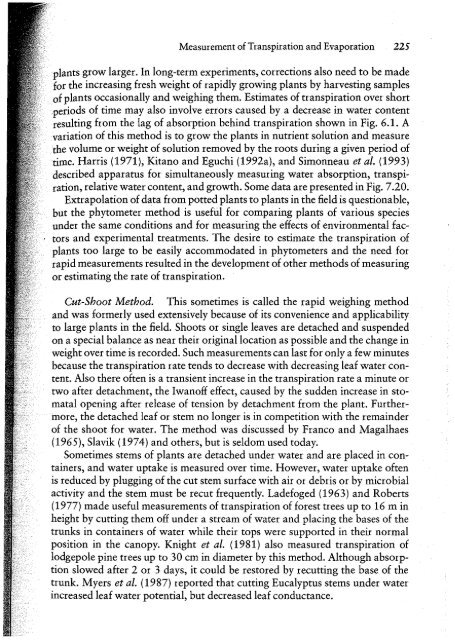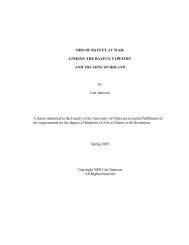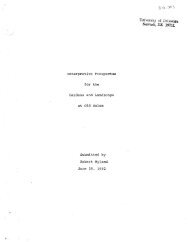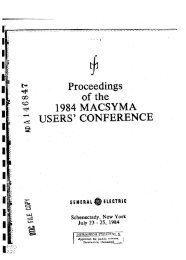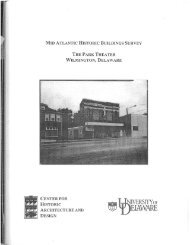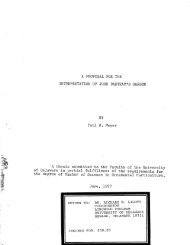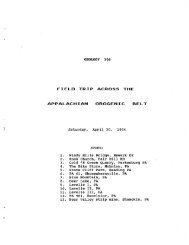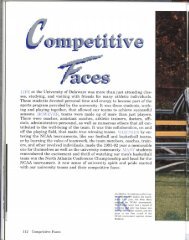Transpiration and the Ascent
Transpiration and the Ascent
Transpiration and the Ascent
Create successful ePaper yourself
Turn your PDF publications into a flip-book with our unique Google optimized e-Paper software.
Measurement of <strong>Transpiration</strong> <strong>and</strong> Evaporation 225<br />
plants grow larger. In long-term experiments, corrections also need to be made<br />
for <strong>the</strong> increasing fresh weight of rapidly growing plants by harvesting samples<br />
plants occasionally <strong>and</strong> weighing <strong>the</strong>m. Estimates of transpiration over short<br />
periods of time may also involve errors caused by a decrease in water content<br />
resulting from <strong>the</strong> lag of absorption behind transpiration shown in Fig. 6.1. A<br />
variation of this method is to grow <strong>the</strong> plants in nutrient solution <strong>and</strong> measure<br />
<strong>the</strong> volume or weight of solution removed by <strong>the</strong> roots during a given period of<br />
time. Harris (1971), Kitano <strong>and</strong> Eguchi (1992a), <strong>and</strong> Simonneau et al. (1993)<br />
described apparatus for simultaneously measuring water absorption, transpiration,<br />
relative water content, <strong>and</strong> growth. Some data are presented in Fig. 7.20.<br />
Extrapolation of data from potted plants to plants in <strong>the</strong> field is questionable,<br />
but <strong>the</strong> phytometer method is useful for comparing plants of various species<br />
under <strong>the</strong> same conditions <strong>and</strong> for measuring <strong>the</strong> effects of environmental factors<br />
<strong>and</strong> experimental treatments. The desire to estimate <strong>the</strong> transpiration of<br />
plants too large to be easily accommodated in phytometers <strong>and</strong> <strong>the</strong> need for<br />
rapid measurements resulted in <strong>the</strong> development of o<strong>the</strong>r methods of measuring<br />
or estimating <strong>the</strong> rate of transpiration.<br />
Cut-Shoot Method. This sometimes is called <strong>the</strong> rapid weighing method<br />
<strong>and</strong> was formerly used extensively because of its convenience <strong>and</strong> applicability<br />
to large plants in <strong>the</strong> field. Shoots or single leaves are detached <strong>and</strong> suspended<br />
on a special balance as near <strong>the</strong>ir original location as possible <strong>and</strong> <strong>the</strong> change in<br />
weight over time is recorded. Such measurements can last for only a few minutes<br />
because <strong>the</strong> transpiration rate tends to decrease with decreasing leaf water content.<br />
Also <strong>the</strong>re often is a transient increase in <strong>the</strong> transpiration rate a minute or<br />
two after detachment, <strong>the</strong> Iwanoff effect, caused by <strong>the</strong> sudden increase in stomatal<br />
opening after release of tension by detachment from <strong>the</strong> plant. Fur<strong>the</strong>rmore,<br />
<strong>the</strong> detached leaf or stem no longer is in competition with <strong>the</strong> remainder<br />
of <strong>the</strong> shoot for water. The method was discussed by Franco <strong>and</strong> Magalhaes<br />
(1965), Slavik (1974) <strong>and</strong> o<strong>the</strong>rs, but is seldom used today.<br />
Sometimes stems of plants are detached under water <strong>and</strong> are placed in containers,<br />
<strong>and</strong> water uptake is measured over time. However, water uptake often<br />
is reduced by plugging of <strong>the</strong> cut stem surface with air or debris or by microbial<br />
activity <strong>and</strong> <strong>the</strong> stem must be recut frequently. Ladefoged (1963) <strong>and</strong> Roberts<br />
(1977) made useful measurements of transpiration of forest trees up to 16 m in<br />
height by cutting <strong>the</strong>m off under a stream of water <strong>and</strong> placing <strong>the</strong> bases of <strong>the</strong><br />
trunks in containers of water while <strong>the</strong>ir tops were supported in <strong>the</strong>ir normal<br />
position in <strong>the</strong> canopy. Knight et al. (1981) also measured transpiration of<br />
lodgepole pine trees up to 30 cm in diameter by this method. Although absorption<br />
slowed after 2 or 3 days, it could be restored by recutting <strong>the</strong> base of <strong>the</strong><br />
trunk. Myers et al. (1987) reported that cutting Eucalyptus stems under water<br />
increased leaf water potential, but decreased leaf conductance.


